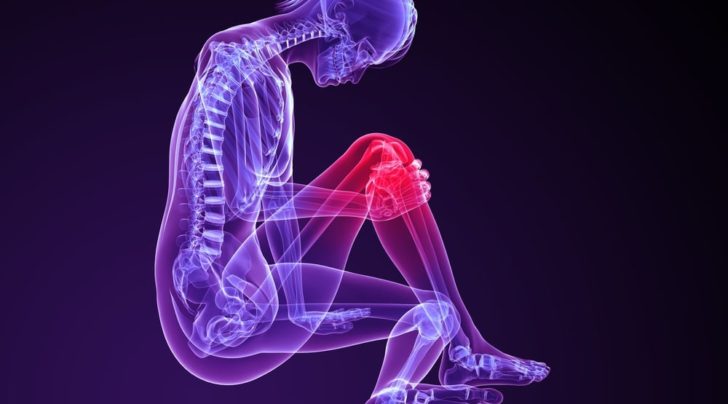
A partial ACL tear is an incomplete tear or injury to the anterior cruciate ligament (ACL). Partial ACL injuries might be treated differently than a complete tear of the ACL. Recovery from a partial ACL tear might be faster than the recovery from a full tear, but it is also a much more complicated decision-making and treatment process. There is a number of variables and considerations that require careful attention in determining how we might treat a partial ACL tear. The goal of the treatment is to minimize the risk of having instability or giving-way episodes.
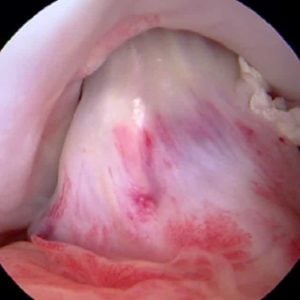
Why do Partial ACL injuries occur?
Most ACL tears occur from non-contact injuries. When you turn, pivot or twist and you feel a pop or tear inside the knee, then there is a chance you injured your ACL. That injury could be a “partial tear” or a “complete tear” of the ACL. Injuries to the ACL or Anterior Cruciate Ligament are becoming more and more common. The ACL is composed of two pieces, or bundles — so it is possible to suffer only a partial ACL tear, as opposed to a complete ACL rupture.
What is the Anterior Cruciate Ligament (ACL)?
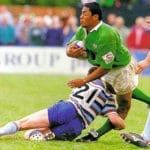
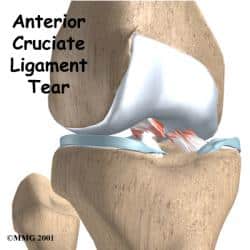
If you have sustained an injury to your knee during a pivoting, or twisting incident, you felt a pop and then noted the inability to walk — as well as significant swelling within your knee — there is a significant chance that you have injured your anterior cruciate ligament.
The anterior cruciate ligament or ACL is the most commonly injured of the four major ligaments that exist within our knee. The ACL is a large ligament composed of two “bundles”. Therefore injuries can lead to a partial (one bundle) ACL tear or a complete ACL tear (both bundles). A good examination by your doctor can often tell the difference between a partial ACL tear and a complete tear. Often times, you will be referred for an MRI to confirm the diagnosis.
Complete ACL Tears:
A complete ACL tear involves the complete disruption of all of the ligament tissue that connected both the femur and tibia. You may simply possess discomfort, pain, and swelling – – – or you may perceive that the knee is unstable and feels like your knee wants to buckle or give way. We have covered the treatment of complete ACL tears elsewhere within this website, and whether or not ACL surgery is necessary as well. I recently placed two ACL Surgery blog posts on this site. The first will help you determine if ACL Surgery is necessary and what questions you should ask your surgeon. And a follow-through post of steps you should take before surgery and after surgery to minimize the risks of complications and improve your overall results following an ACL reconstruction.
Partial ACL Tears
A partial ACL tear involves an injury to only a portion of the ACL. The normal ligament has an Anteromedial bundle and a Posterolateral bundle. A partial injury means that only one of the two bundles was torn. Therefore, the second bundle is intact. Many patients who sustain a partial ACL tear will be able to return to their prior level of activity without complaints of buckling, instability or giving way. It may, however, take many months to recover from the injury and to complete the extensive rehabilitation necessary.
Unfortunately, a fair number of you with a partial ACL tear will not be able to return to sports because your knee feels unstable or loose. Therein lies the issue with partial ACL tears … some people with a partial tear will not complain of instability of their knee with sports, but some might.
What I’m getting at is simply the fact that we should not look at your ACL tear as being “partial” or “complete”, we look at your KNEE as being “functional” or “non-functional” or “stable” vs. “unstable”.
If you have a functional and stable partial tear of your ACL, that means that you have torn a certain portion of your ACL fibers, however, you are still able to participate in sports without the feeling of the knee giving way or being unstable. If you possess a nonfunctional partial tear of your ACL, that means that you have torn enough of your ACL fibers that your knee no longer feels stable. That means that you are at risk of further injury if you return to your prior level of sports participation. Every time your knee buckles or gives way you run the risk of tearing other structures within the knee, such as the medial or lateral meniscus. If you sustain tears of either the medial or lateral meniscus, which are the shock absorbers within the knee, then you are at risk of developing osteoarthritis. You, therefore, want to eliminate or minimize the risk of buckling, instability or giving way and therefore a patient who presents with a partial ACL tear, who complains of instability, will likely present as an appropriate candidate to consider an ACL reconstruction or possibly an ACL augmentation.
ACL Repair and Treatment Options – If Partial ACL tear surgery is necessary
The difference between an ACL reconstruction and an ACL augmentation is fairly simple. During the process of an ACL reconstruction, we will reconstruct or replace the entire ruptured ligament. Anatomically, the ACL is composed of two separate bundles and a complete reconstruction will compensate for both of those bundles. In an ACL augmentation, you have only sustained a partial tear. That means that a portion of your ACL remains intact and should be normal. Many competent sports medicine orthopedic surgeons are capable of reconstructing only the torn portion of the ligament, leaving the normal portion alone. There are many advantages to an ACL partial tear augmentation over a full ACL reconstruction. While the discomfort and the nature of the surgery are virtually identical – – – it is far more likely that someone who undergoes an augmentation will have a much more natural feeling knee when all is said and done. The reason for that is because the normal ACL has certain nerves within it. Those nerve fibers give the brain certain feedback as to the position of the knee joint. It turns out that those nerve fibers are quite important. If we preserve the intact portion of your ACL, then we are preserving those nerve fibers and hopefully preserving the integrity of your knee in the long run.
In some published series, up to 50% of athletes can be expected to return to sports with a partial ACL tear which is treated without surgery. Before returning to sports, an athlete should complete a formal rehabilitation program. A thorough evaluation by your doctor, physical therapist or athletic trainer should also be performed to make sure that your knee is properly rehabilitated and ready to return to the field.
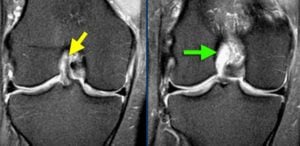


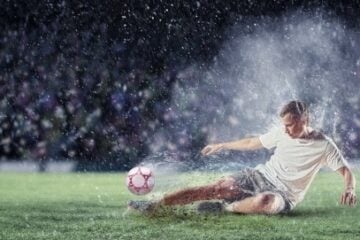
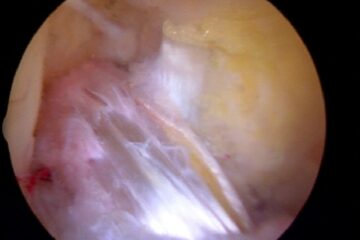
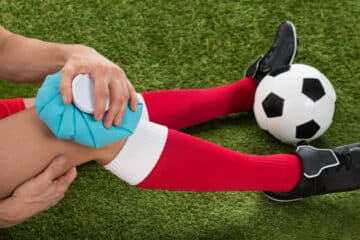
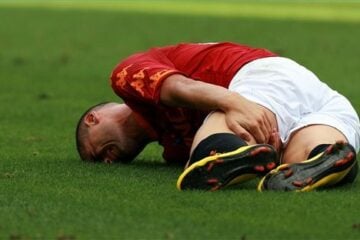




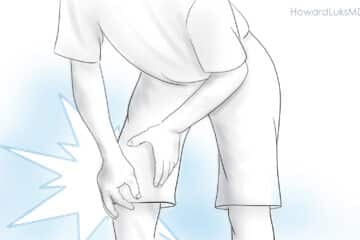



Dear Doctor Luks,
I am 44 years old from Galle Sri Lanka. I play badminton since the age of 8 for my school , university and the club.In 2012 August I had left knee injury- lateral collateral ligament tear at its insertion to the femoral condyle, anterior cruciate ligament tear (Report has not mentioned whether it is a 100% tear or not) and tears in of posterior horns of both menisci and meniscal cyst in relation to lateral condyle (M.R.I report- 2013/11- got late due to technical reason) while playing badminton.I had pain, mild swelling and restricted movements initially but with physiotherapy and anti inflammatory drugs now I can walk fast and climb stairs (with mild weakness) without pain and discomfort . I notice some muscle wasting in my left thigh. I did not attempt running or playing badminton, but now I enjoy swimming without painful knees.I do not intend to play badminton.
Can you please tell me , Dr Luks
1. the suitable mode of treatment considering the future course of my life.
2. I f it is not reconstruction of A.C.L. what is the likelyhood of osteoarthitis in my knee.
3.the sport activities and exercises suitable for me to avoid muscle wasting further and keep me fit.
thanks,
Heshan
With a multi-ligament injury – the ACL and LCL – you are at very high risk of having significant instability and giving way. If that happens then you can suffer other injuries such as meniscus tears or damage to the cartilage.
Unfortunately with a multi-ligament injury and a meniscus tear, you are at an elevated risk for developing arthritis. Weight training under supervision in a gym would likely be well tolerated. But any sports would be not be advisable given the unstable nature of your knee.
Good Luck
Howard Luks
Dear dr.lucks
i fell on my leg while playing soccer 3weeks ago. My i have a partial acl tear. Doctor took away my meniscus. Since the operation i have been takin phsical treatment everday. Now my knee stabilty is getting well gradually and i can walk. What should i do to recover fullly. İ afraid of using my leg in case i can hurt my acl totally. İs it possible to tear it totally while trying to streghten my leg and what exercises should i do to streghten my leg.need your help, thank in advance
Hello, I am 18 years old and I was playing basketball and when I jumped up for the rebound I felt shakingon my knee than I went to the ground and was unable to stretch my leg. After 20 seconds I slowly stretched it out and it felt like something poped into place. I did not hear a pop though. Its been a month exactly that I have had this injury. I went to an orthopedic doctor a few days ago and got my MRI done and I woll find out exactly what I have in 1 week. My orthopedic doctor thinks it may be a parcial acl teae after some movements with my leg. I have been able to walk fine with and without a brace. However , yesterday while walking I was not paying attention and my leg locked and leaned back and I got pain for about 30 seconds. I dont mot feel pain though on the acl. My injury is on my left leg and on the left side of my knee. I truly hope I didnt do more damage to any of the ligaments and am placing ice on it every day to ensure I do not injure it. My legs do not lock up. I dont even feel pain when I walk. The only time I ever feel pain is if my leg straightens and I put weight when it leans back. Please respond. Im a kid whos freaking out that he may never be able to play basketball again. What do you think it might be? And what type of surgury would you recommend? Iv been told of many types of way but is it really good to take a piece of your hamstring out to heal your ACL? I would love some feedback. Thankyou
David.. I’m sorry that I’m not going to be able to be of great assistance to you tonight. Too little information.. and I can’t offer treatment recommendations to people online who are not patients of mine. Given the injury that you note, it MIGHT not be an ACL issue, but MIGHT be a bucket handle meniscus tear. That would explain the locking you experienced. Time will tell young man… let’s see what the MRI shows. Feel free to come back after you have some more information. Please understand that this is for informational purposes only.. it is not meant as a diagnosis or treatment recommendation. To avoid further injury you can talk to your surgeon about whether or not crutches would be useful to prevent further injury, until you know the results and have a plan in place.
Good Luck
Howard Luks
I do apoligize for the questions. I didnt notice until I reached the bottom of the page, thankyou for the input though! The doctor however told me not to use crutches. He didnt really get much into detail. But I figure he knows best.
Hi doc I’m 18 yrs old , exactly three and half months ago my knee got hurted as the result of playing football. On the spot I went to doctor and he said you should do an MRI to clarification of the issue. After that I did MRI and the result shown as an impression: 1- Mild effusion, suprapatellar bursa 2- Early onset Grade-I meniscal changes, posterior horn of medial meniscus. When I did MRI, the result did not show that the ligament is hurted, but it was. By considering the above results, the doctors said that you should be operated and I did accept it. The doctor said after 15 days you will be absolutely fine, but: v After operation (one and half month) I felt that my knee has not become fully fine yet. And I went again to doctor and he said you need to do MRI once again to have a better understanding and I did. And this time, the result shown ACL partial tear.
The doctor said don’t go for operation and do the exercises but I’m disturbed alot so what’s your opinion.
Can I do the operation ?
I want to be absolutely fine as soon as possible it is.
I’m sorry Sohail .. I can not make specific recommendations to people who are not my patients.
Good luck to you.
/hjl